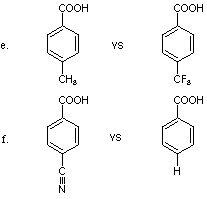![]()
![]()
1. Specify the member of each of the following pairs that is more acidic. Explain your choice in words and with the help of structures.
a. CH3COOH vs FCH2COOH
b. CF3COOH vs CCl3COOH
c. CH2=CHCH2COOH vs HC=CCH2COOH
d. NCCH2COOH vs HC=CCH2COOH

2. The ester shown is labeled with oxygen-18 as indicated (*O=18O). Give a mechanism consistent with the labeling results shown when the ester is hydrolyzed in unlabeled water at pH = 2.
3. Each of the following reactions involve nucleophilic substitution at an acyl carbon (carbonyl of a carboxylic acid or derivative) by way of a tetrahedral addition intermediate. Write a general mechanistic scheme (use curved arrows to show movement of electron pairs) for these reactions, keeping in mind that acid and base catalyzed processes will differ in timing of proton transfers. Construct a table showing the electrophile and the nucleophile in the key bond-forming step and the corresponding tetrahedral addition intermediate for each reaction.